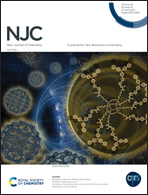Design, synthesis, and photophysics of bi- and tricyclic fused pyrazolines†
Abstract
Three series of bi- and tricyclic functionalized new pyrazoline fluorophores have been synthesized for investigation of their photophysical properties. Spectral studies indicated significant absorption and emission properties. The quantum yields reached 93% and Stokes shifts increased up to 148 nm. The compounds exhibited positive solvato(fluoro)chromism. Fluorescence was sensitive to both structural changes and the microenvironment, especially to protic solvents, such as EtOH, n-BuOH, and DMSO/H2O mixture, and ethylene glycol. The experimental findings were supported by quantum mechanical calculations. Modification of the electronic nature of the substituents and their spatial effects can change the nature and direction of intramolecular charge transfer (ICT). These findings provide valuable insights for the development of new fused pyrazolines with tunable photophysical properties. The pyrazolines exhibited high intensity solid-state emissions, making them suitable for applications in photonics. Active functional groups may be used to bind pyrazolines and natural compounds, drugs, and diagnostic molecules, for possible use in biological systems and medicine.



 Please wait while we load your content...
Please wait while we load your content...